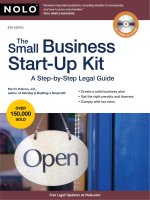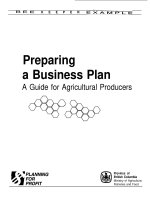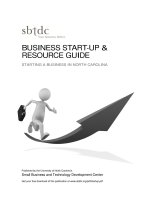In good comapny the essential business start up guide for woment
Bạn đang xem bản rút gọn của tài liệu. Xem và tải ngay bản đầy đủ của tài liệu tại đây (6.86 MB, 257 trang )
In Good Company
In Good Company
The essential business start-up
guide for women
Rebecca Jordan and Kirsty Weir
First published in Great Britain 2006
A & C Black Publishers Ltd
38 Soho Square, London W1D 3HB
© Clear Content Ltd, 2006
All rights reserved; no part of this publication may be reproduced, stored in a
retrieval system, or transmitted by any means, electronic, mechanical,
photocopying or otherwise, without the prior written permission of the
Publisher.
No responsibility for loss caused to any individual or organisation
acting or refraining from action as a result of the material in this
publication can be accepted by A & C Black Publishers Ltd or the
authors.
British Library Cataloguing in Publication Data
A CIP record for this book is available from the British Library.
ISBN-10: 0–7136–7626–4
ISBN-13: 978–0–7136–7626–6
eISBN-13: 978-1-4081-0186-5
A & C Black uses paper produced with elemental chlorine-free pulp, harvested
from managed sustainable forests.
Design by Fiona Pike, Pike Design, Winchester
Typeset by RefineCatch Limited, Bungay, Suffolk
Printed in the United Kingdom by Bookmarque, Croydon
Contents
Thanks
x
INTRODUCTION
★ About us
★ The ‘entrepreneur’ thing
★ The ‘small business’ thing
★ The ‘woman’ thing
★ How the book works
1
1
2
4
5
6
1
THE IDEA
★ The right idea
★ The right attitude
★ Identifying the best idea
1 How much money could the idea make?
2 How would the implementation of the
idea affect your life?
3 How much value potential does the idea
have?
4 Would the pursuit of the idea make the
most of your skills?
9
9
11
13
14
14
14
15
v
CONTENTS
★ The right time
★ How the idea for Kirsty’s previous business came
about
★ Do you have to love your idea?
★ Finding your inspiration
★ Top tips for finding inspiration
★ Get the basics: you don’t always need your own
idea
★ Finding out about your competition
★ Get the basics: protecting your intellectual
property
★ Protecting your idea
★ Having a Plan B
★ Ten of the best business ideas – ever!
★ And ten of the worst . . .
★ Your elevator pitch
★ The power of the written word
★ Our goal-writing guidelines
★ Get an ideas process
2
vi
MONEY
★ Sources of funding
★ Advertising and sponsorship
★ Get the basics: choosing your trading status
★ Should you sell equity in your business?
★ Get the basics: selling company shares to raise
equity finance
★ Get the basics: funding your business
★ Get the basics: costing your business
★ Managing your money
★ A crash course in electronic book-keeping
15
18
21
21
22
23
26
27
30
33
34
37
38
40
41
43
46
49
49
50
55
55
63
72
77
78
CONTENTS
★
★
★
★
★
3
4
To sum up . . .
Writing a business plan
Get the basics: why write a business plan?
What your business plan should contain
FAQs
83
83
84
86
89
PEOPLE
★ Human resource planning
★ The recruitment process
★ Write a job description and a job specification
★ Where to find staff
★ Conducting interviews
★ The job offer
★ Personnel files
★ Contracts of employment
★ Managing staff
★ Understanding yourself and your role as a
leader
★ Retaining your staff
★ Get the basics: maternity and paternity leave
★ Managing the performance of staff
★ If you need to get rid of someone
★ To sum up . . .
91
93
95
95
98
106
109
113
114
116
FINDING PREMISES
★ Get the basics: premises – your three main
options
★ Office hunting
★ How to find business premises
★ To sum up . . .
131
120
122
123
125
127
130
133
139
147
149
vii
CONTENTS
5
GROWING YOUR BUSINESS: MARKETING
★ Identify your market
★ Find a channel to your market
★ Get the basics: writing marketing copy
★ Get the basics: search engine optimisation
★ Get the basics: writing a press release
★ Branding
★ Writing your marketing plan
★ To sum up . . .
150
151
153
163
171
183
185
186
187
6
GROWING YOUR BUSINESS: SALES
★ The sales process
★ How to win prospects and influence people
★ Decision-makers
★ Networking FAQs
★ To sum up . . .
189
191
194
197
199
204
7
YOUR BUSINESS AND YOU
★ Balancing business and kids
★ Balancing work time and personal time
★ Balancing your business and your health
★ Manage your time
★ Your personal wellbeing account
★ Dealing with stress
★ Looking the part
★ To sum up . . .
205
206
211
215
218
221
223
224
228
8
EXIT
★ How long do you want to run the business for?
★ To what extent do you want out?
★ Typical exit options
★ Selling your business
229
230
231
232
233
viii
CONTENTS
★
★
★
★
★
Valuing your business for sale
Keeping it in the family
MBOs and MBIs
Floating your company on the stock market
To sum up . . .
THE END?
Useful links and numbers
Index
233
234
234
235
235
236
238
243
ix
Thanks
We would like to say a big thank you to the following: our
families and our wonderful husbands for all their support,
Dave for his contacts, to all the brilliant businesses who have
contributed to this book and to those good angels, business
and otherwise, who have helped us along the way.
Introduction
ABOUT US
T you will learn a lot about how we set
up and grew our business over a five-year period. The business
is still growing and changing. We started with an idea for a
youth travel website at Gapwork.com. This then became a
publishing company, and then we started to sell into schools
and build the range. We are now an educational publishing
company, employing a team of people, and selling into over
70% of the UK schools market. This year we have re-branded
Gapwork Ltd as PDC Education Ltd, to reflect better the fact
that it has become an educational publisher. It may seem at
times that there has been little strategic planning involved in
the course of our business, but while strategic planning is
important, far more important for the survival and growth of a
start-up business is being able to adapt to change and to capitalise on new opportunities. This is what makes running your
own business exciting – the fact that things change all the time
and that new opportunities rear their heads on a regular basis.
When we started out, we had no idea of what we personally were capable of achieving. But change forces you to take
action and, before we knew it, we were employing a team of
1
IN GOOD COMPANY
people, managing production processes, speaking at large
events, pitching to major blue-chip companies and meeting
Gordon Brown!
One of the best things about deciding to set up your own
business is knowing that you will never be bored. You will
never clock-watch. You will never wonder how you can kill
time until 5.30 pm. You will never know what is around the
corner. If this sounds like a challenge, it is. Read on and decide
if you are up for it!
THE ‘ENTREPRENEUR’ THING
When we set up our business, we never had a grand vision of
how it would grow or develop. We started out with an idea for
a website, which we got up and running, and then just kind of
went with the flow – using our skills the best we could, learning fast and not being afraid to venture into the unknown.
Over a five-year period, the website idea developed into an
educational publishers, employing 15 people, producing up to
four new products a year and turning over three-quarters of a
million pounds.
When we were approached to write a book about our
experiences, we wondered whether we were qualified to do so.
After all, we weren’t running a multi-million pound corporation. But then we realised that the sum of our experience was
greater than the size of our company; we could certainly share
some of this experience if it might help other people considering going it alone. We gained some public recognition when
we won the Parcelforce & Sunday Express Young Entrepreneur of the Year award in 2003, and then went on to write
business advice columns for the Yorkshire Post and the Sunday
Express – so the idea of a whole book wasn’t too far from
what we were doing already.
2
INTRODUCTION
It is an interesting concept, being an entrepreneur, and one
which hadn’t really occurred to us before going for the award.
Entrepreneurs are people like Richard Branson or Philip
Green – people who start with nothing and end up building
huge businesses and being multi-millionaires. We wouldn’t
object to owning our own jets or giving ourselves £1.2 billion
dividend payouts, but we never wanted to run a business
which would mean spending all our time in the office or on
the road and employing hundreds of people. The world of
corporate dog-fighting was not what we had in mind when we
wanted to set up our own business. In fact, we knew that we
wanted to do something completely different to what the
world of suits, career ladders, office politics and clockwatching had to offer. Our key priorities were to make enough
money to live the lifestyle we wanted to live, to do something
creative and interesting, and to work together, as we had been
friends for a few years and thought that we could work well in
partnership.
So did this make us entrepreneurs? Entrepreneurial skills
include the ability to adapt well to change, to take calculated
risks, to think creatively, to solve problems effectively and to
have a ‘can-do’ attitude. This being the case, we definitely are
entrepreneurial and we are proud to say so. Entrepreneurs have
a somewhat one-dimensional representation in the UK media.
Branson, Green and Stelios are held up frequently as the
definitive entrepreneurs – the flipside being the slightly shady
wheeler dealers, the Del-boy type. We would venture to say
that there are few women running their own businesses in the
UK who would identify with any of these men when it comes
to considering themselves as entrepreneurs.
But there is more to being an entrepreneur than just making loads of money. The skills we have already mentioned –
3
IN GOOD COMPANY
creative thinking, adapting to change, risk-taking etc – are
skills which anybody running their own business needs to
develop, regardless of the size of that business. To run a
successful business of any shape or size requires the owner/
manager of that business to show some entrepreneurial skills.
If your business is a success, then you are using your entrepreneurial skills; you are therefore an entrepreneur. It is time to
reclaim the word ‘entrepreneur’ from the slightly dubious
media territory which it occupies at the moment and use it in a
positive way to describe what you have to be on a daily basis
to make your business succeed. Describing yourself as an
entrepreneur should be a positive, life-affirming statement.
We hope that this book enables more women to describe
themselves as entrepreneurs with confidence and self-belief.
THE ‘SMALL BUSINESS’ THING
Size isn’t everything. It’s a tough one for many people to get
their heads around, but there are very many hugely successful
businesses which are relatively small in terms of turnover,
number of employees and profitability. ‘But how can this be?’
we hear a multitude of business writers, analysts and leaders
exclaim. It is simply because the success of a business is, or
should be, defined by the person who sets it up. As an owner/
manager of a business, your success could be defined by many
things unrelated to turnover or profitability. You could define it
by the amount of time it allows you to spend with your family,
by how good the relationship is that you have with your customers, or by the creative challenges it gives you. Obviously a
business has to make money to survive, but this is only a
means to the personal satisfaction of the individual running
that business. The success of a business is to some extent a
subjective thing. If the owner/manager is happy with what
4
INTRODUCTION
they do, then they judge the business to be a success. This
personal relationship between an individual and the business
they set up is difficult for the outside world to understand.
Hence the reason that a business is usually described as
‘successful’ when it is making lots of money, as this is easy to
identify and measure.
We know this isn’t the case and we want to challenge the
traditional ‘size and growth’ definition of business success in
this book. Just because you don’t want to be the next Richard
Branson or Anita Roddick (see how we struggle to identify
another female entrepreneur who everyone will have heard
of ) doesn’t mean that you can’t run a brilliantly successful
business and proudly describe yourself as an entrepreneur.
So what you won’t find in this book is a magic recipe for
making a million. There are no get-rich-quick tips or advice
from billionaires about how they went from corporate takeover to strategic merger to buy their Caribbean island. What
you will find is lots of firsthand experience from other women
who run businesses that are successful on their own terms.
THE ‘WOMAN’ THING
We have met many women running their own businesses in
the last five years. These vary from small enterprises that pay
their owners enough money to meet the bills and go on holiday twice a year, through to women running operations with
multi-million pound turnovers and hundreds of employees.
There is no shortage of women starting and running their own
business, it’s just that you don’t often hear about them. So
when we were talking about writing this book, we thought,
well it’s got to be a positive thing, because we know there are
lots of women out there who are thinking about setting up
their own business or who are already running one. We
5
IN GOOD COMPANY
wanted to include input from women owner/managers, and
we wanted to get advice from experts who happen to be
female.
This isn’t through any bra-burning ambition to exclude
men entirely, however. It is simply a redressing of the balance
in terms of business writing. Pick up any business supplement,
any top-100 list on business topics, business magazine or website, and you could be forgiven for thinking that women don’t
work at all. There might be a handful of women mentioned,
but this is disproportionate to the reality of the situation –
which is that there are plenty of successful female entrepreneurs out there, they are just either reluctant to identify
themselves as such, or they do not have access to the media in
order to boost their profile.
The focus on women in this book isn’t meant to exclude
men from its readership. Many (if not most) of the issues
faced by women starting up are common to businesses owned
by men too. But by concentrating on women-owned businesses, we are hopefully helping the reader to identify with
and be inspired by our own experiences and those of other
women.
HOW THE BOOK WORKS
Each chapter is designed to be read either as part of the whole
book, or in isolation. We know that when you are setting up
your own business you don’t have a lot of spare time for
ploughing through books. So just pick it up when you are in
need of some general information or inspiration, or when you
want to know how we dealt with something specific.
The chapters are organised roughly in terms of the themes
you will need to tackle when planning your business or when
running it in the early days – first comes the idea, then the
6
INTRODUCTION
requirement for funding, then for staff and so on. At the end
of each chapter there is a brief summary to recap on what has
gone before.
Most chapters include case studies of women who have
successfully set up their own businesses. These include websites, training organisations, day nurseries, manufacturers and
lots more besides. We deliberately wanted a wide range of
enterprises to be included, to illustrate our point that women
are running businesses of all shapes and sizes. The chapters
also contain sections called ‘Get the Basics’ which are simply
summary sections covering the core issues.
You will notice that we don’t cover tax and red tape in
much depth. This is because it is difficult to offer really helpful
information on these for all businesses without going into
masses of detail. To find out more about these issues, go to the
business support organisations in the ‘Useful Links’ section
on page 238, where you can get answers straight from the
horse’s mouth. If you can’t find the information you need
online, try calling the relevant organisation direct. We have
always found Companies House, the Inland Revenue and
ACAS very helpful when it comes to getting information
and guidance about company law administration, tax, VAT
and employment law, for example.
We are conscious that in telling our story in a totally honest, ‘no holds barred’ fashion, we are telling it warts and all.
We would hate for the warts to deter anyone from having a go
at setting up something that they believe in. Our problems
won’t necessarily be your problems, and by reading about
them, you will hopefully learn from our experience and be
aware of the pitfalls. Running your own business should be
one of the greatest challenges that you face. It could change
your life and the lives of those around you, so it would be
7
IN GOOD COMPANY
irresponsible of us not to highlight things that can go wrong,
as well as the things that are great about it.
Have fun with what you do and accept that while you can’t
do everything, you can still have a bloody good go. The stakes
are as high as you want to make them – and if your business is
a success, you will be not only financially better off, but you
will have achieved the work/life balance which you have
always dreamed of.
8
1
The Idea
I what the key to business
success is, the chances are that you would get a variety of
answers. Some people would say that business success is all
about money, because if you don’t make enough of it, you
won’t stay in business for very long. Others would claim that it
is all about people and that relating well to both staff and
customers is the most essential factor.
For us, the key to business success is the idea. Obviously
we agree that a successful business also needs to make money,
and that it’s important to recruit the right people and relate
well to customers. But without a good idea to begin with,
everything else is just window dressing.
THE RIGHT IDEA
Everything that you see around you was once someone’s
bright idea – from the electric lights in your office to your
desk and even the book you are now holding in your hands.
Although each of these things is very real right now, they all
started as nothing more than an idea.
Contrary to popular belief, coming up with the right idea
– one that other people will pay for or buy into – is not rocket
9
IN GOOD COMPANY
science. In this chapter we will explain how ideas can be
generated, how you can develop them and how you can protect them. We will also supplement this with a variety of case
studies so that you can see how the various principles we share
have been applied to great effect in the real world.
DEBORAH LEARY WINS BRITISH FEMALE INVENTOR OF THE YEAR AWARD
In 2005, Deborah Leary won the British Female
Inventor of the Year Award for her work with her
company, Forensic Pathways Ltd (FPL). This is her
account of how it happened.
In March 2001, I had just left my post as a training and
development manager in education and was due to commence
a lecturing post at a college in Sutton Coldfield, teaching
Business Administration. During the three-week break
between the two jobs, I attended the Forensic Identification
Conference in Toronto with my husband, who was speaking at
the conference. He was at this time a serving police officer
with West Midlands Police.
During the course of the conference, I became involved in a
discussion between officers from different forces and
countries, relating to the procedures and equipment used in
each jurisdiction. One piece of equipment – the crime scene
stepping plate – was found to be used in the UK only and was
not known to the Canadian forces. (Stepping plates are lowlevel platforms that are placed on the floor of a crime scene so
that an investigator can walk through it without causing cross
contamination or the destruction of evidence.) I still have the
original hotel notepaper on which I made a note to find out
about the plates and to set up a company to supply to
Canadian forces!
10
THE IDEA
Back in the UK, I obtained a sample of the plates and found
that, while useable, they were not necessarily fit for their
purpose. They were aluminium, heavy, covered with ridges
which could trap dirt, could not be stacked and, most
importantly of all, were not transparent. With no knowledge of
the plastics/moulding industry, I set about investigating the
possibility of designing a plate which could revolutionise crime
scene management, providing a transparent, lightweight,
stackable product. The key to this was liaising with the end
user, sending out a mailshot outlining the design of the new FPL
plates. The response was outstanding, giving a clear indication
that there was a market and that it was ready for change.
Visit FPL’s site at: www.forensic-pathways.com
Many people get their business ideas through the kind of
personal experience that comes from having an interest in a
particular hobby or by working in a particular field as an
employee. Others get their ideas by listening to other people’s
experiences. Our own idea stemmed from the observation that
that there was no website on the Internet which gave young
people the information they needed to find seasonal work
abroad. Both of us had both worked overseas, in Australia and
Italy respectively, so we had firsthand experience of how difficult it could be. We’ll tell you more about how we fleshed out
this spark of an idea a little later, but first we need to take a
temporary detour in order to discuss . . .
THE RIGHT ATTITUDE
Although having a good idea is important, it isn’t enough
by itself. After all, there are thousands of people who have
11
IN GOOD COMPANY
good ideas all the time and never do anything with them. The
missing ingredient is confidence; it is this that enables you to
take your ideas further, to act on them. If an idea on its own is
a good one, then when it is coupled with a confident attitude it
can be an incredibly powerful thing.
Being entrepreneurial means being optimistic and believing that anything is possible. This doesn’t come easily to many
people, but it is a skill that can be developed if you go about it
the right way. This means disciplining yourself to think more
positively whenever you are presented with opportunities and
taking control over the voice in your head. Many people,
when they come across an opportunity, immediately hear a
gloomy inner voice which provides a long list of reasons why
they aren’t in a position to jump at the chance. This kind of
negative self-talk is largely habitual and is completely
unrelated to what you are really capable of, so you should get
into the habit of transforming all your pessimistic thoughts
into their optimistic opposites, as below:
★ Whenever you catch yourself saying ‘I can’t’, say ‘I can!’
★ Whenever you want to say ‘no’ just because you think
you might fail, say ‘yes!’
★ Whenever you start listing all of the reasons why you
can’t do something, ask yourself the question ‘How can
I make this work?’ instead.
It is amazing how changing the way that you think, about
yourself and the opportunities that come your way, can have
an immediate positive impact on your life. You don’t have to
stand in front of the mirror and affirm belief in yourself at
every opportunity (although this works for some), but by
developing the simple habit of thinking more positively, you
12
THE IDEA
will experience a subtle change in the way that you perceive
the world.
As we said a moment ago, thinking in this way doesn’t
come easily to many people. Being a bit cynical, pessimistic
and self-deprecating is something peculiarly British, and
maybe women are more self-deprecating than men. But to get
your business idea really up and running, you need to believe
in it. You also need to be able to persuade other people to
believe in it too. The only way that you can do all of this is by
being relentlessly positive and open-minded, and by telling
other people why your idea is such a fantastic one. If they can’t
or won’t feel the same way about your idea, then that’s their
problem. Keep on going and you will find that there are
always plenty of other people out there who will share your
vision if you project it with enthusiasm.
This positive outlook on life is often described as a ‘can-do
attitude’. To those of us with small children, the phrase
immediately conjures up an image of flushable toilet tissue –
but it is probably the best way of describing the mental
approach you need to have to get where you want to be in life.
IDENTIFYING THE BEST IDEA
Ideas, like buses, rarely turn up in isolation. Instead you will
find that ideas have the habit of following hot on the heels of
one another. In other words, once you have had one good
idea, you can often expect another to pop up, and then
another, and yet another. This could leave you facing the
welcome challenge of having to decide which of your ideas is
the best one to pursue.
Choosing between ideas effectively is something that can
only be done by asking yourself a number of specific questions
and taking the time to answer each of them to the best of your
13
IN GOOD COMPANY
ability. In our experience, the four key questions you need to
ask are as follows:
1 How much money could the idea make?
You will obviously have to take a bit of a guess at this stage,
but if you focus on the potential market for the idea then you
will have a fair clue as to how profitable it could be. For
example, if your idea is to grow organic vegetables in your
own garden, then you aren’t likely to land a major contract
with a national chain of supermarkets. However, if the idea is
for a propagation gadget that would enable people to grow
their own organic vegetables more effectively, the market for
that idea – and therefore the potential profit – would be much
bigger.
2 How would the implementation of the idea affect
your life?
Turning an idea into reality is not something that happens
automatically. It requires effort, energy, time and money. However, some ideas are likely to be more demanding than others.
So you need to take a good look at your existing commitments
and examine honestly what impact the idea would have on
your life if you were to take action on it. If the price for going
ahead is too high, you either need to change your existing
commitments or to favour a different, less demanding idea.
3 How much value potential does the idea have?
We’re not talking about value in terms of potential profit here,
because we’ve already assessed that. Rather, we are talking
about the value that the idea could bring to the lives of other
people. It is always more fulfilling to take action on an idea
that will serve others as well as ourselves. This kind of idea is
14









